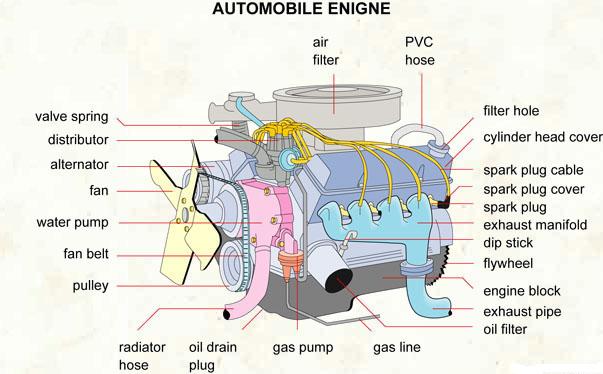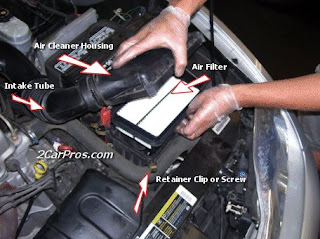How many types of engines exist ???........ For Cars mind you...
 |
| Benz Tricycle |
Yes the first driver was a woman... :S.....Lets not dwell in it. the real reason i brought this up was that the engine that Karl Benz put into his tricycle & later patented in 1896 was a Flat Engine.
So.........
 |
| Flat Engine Arrangement |
Since you have a basic understanding of how the engine works from the previous post, it'll be easier to understand how these structures actually work. How this works is basically very simple in nature. The pistons are arranged in a horizontal position facing away from each other.
This engine structure is not very commonly used today, however its popularity began because it was the engine structure used in the Volkswagen Beetle air cooled engine. Later on it was adopted by Porsche in their beginning days and is still used in their cars to date. More modern users of this engine type is actually Subaru subsidiary of Fuji Heavy industries.
 |
| Subaru Flat Engine |

The advantages to using this engine include, Claimed to have Better Fuel Economy vs Torque and also the most important advantage is that flat engines provide much more better handling and balance to the car that other types of engines. the reason is this. Have you noticed when you rev your engine while on stand still the engine tends to twist and along with it the whole car twists. This effect causes imbalance. Having the cylinders in line or in the V line up would cause internal imbalance in the engine because there is no counter to the force of the pistons hammering down on the crankshaft. in the case of flats the cylinder opposite acts as a counter to the force exerted. Therefore there is less deflection in flats as opposed to other structures.
Also Flat engines are actually shorter therefore can be mounted lower in the car, hence lower center of gravity contributing to improved handling.
Flat engines can range from configurations of Twin Flats to 24 flat engines
 | |
| Porche Flat Engine |

Type 2 - In line/ Straight Engines.
One of the most common engine formats used today. The cylinders are arranged in a row next to each other. This format is widely used because of its low cost and low complication. Although in lines sound a little boring, they are still known to provide adrenaline pumping power in their straight 6 forms. The straight 6 and the straight 4 are two of the most commonly used of the In line segment.
They can be found in cans such as the BMW Z4 or the BMW 1M
Straight engines range from Straight 1's to Straight 24's

Type 3 - V Type Engines.
Another one of the most popular types of engines used today. The V's are basically 2 rows of cylinders arranged together in 2 rows sharing one crankshaft. Giving the overall appearance/ shape of the letter V (hence its name). V's are basically used because of the low space use age. It saves up space in terms of overall length and height. The complexity in V's lie in its balance. Since one crankshaft supports 2 rows of Pistons, the firing order of the cylinders should be controlled to preserve this balance. The most common configurations of the V type engines are V-4, V-6, V-8 & V-12 Configurations.
V's can be found anywhere from the least powerful of cars to the most powerful of cars.

V type engines can be in the range from V-2 up to V-24
Type 4 - W Engines.
 Although not very popular W engines are known to power some of the worlds most powerful cars. How W engines work is basically 3 (traditional design) or 4 (Modern design) rows of pistons connected by one crankshaft. They can also be looked at as 2 V engines joined together at the crankshaft. This structure is very complex in nature although can pack in more cylinders with less a lesser space consumption and weight.
Although not very popular W engines are known to power some of the worlds most powerful cars. How W engines work is basically 3 (traditional design) or 4 (Modern design) rows of pistons connected by one crankshaft. They can also be looked at as 2 V engines joined together at the crankshaft. This structure is very complex in nature although can pack in more cylinders with less a lesser space consumption and weight.
W Engines can be found in the Bugatti Veyron & the Bentley Continental
W engines exist in formats W-8, W-12, W-16, W-24
_%E2%80%93_Frontansicht_(1),_30._August_2011,_D%C3%BCsseldorf.jpg)
 Type 5 - The Wankel Engine.
Type 5 - The Wankel Engine.This is the single different engine structure that makes me want to change the name of my blog. The magic in this engine is that it does not have pistons. instead its got a series of rotors that does the job of the piston. Designed by Felix Wankel in 1929 it was made proponent by the Japaneses company Mazda. Today we can see this engine in the Mazda RX- 8. The main advantages of the Wankel is that the engine is extremely small but is capable of producing massive amounts of power. The downside is that the fuel economy is horrible.
How it works is explained in the pictures below:
Intake:The fuel/air mixture is drawn in the intake port during this phase of the rotation.
Compression: The mixture is compressed here.
Combustion: The mixture burns here, driving the rotor around.
Exhaust: And the exhaust is expelled here.
The rotary motion is transferred to the drive shaft by an eccentric wheel (illustrated in blue) that rides in a matching bearing in the rotor. The drive shaft rotates once during every power stroke instead of twice as in the Otto cycle.
The Wankel promised higher power output with fewer moving parts than the Otto cycle engine; however, technical difficulties interfered with widespread adoption. In spite of valiant efforts by Mazda, the four stroke piston engines remains much more popular.
So, Insult to Intelligence??.. I hardly think so.. Cheers!!!






































